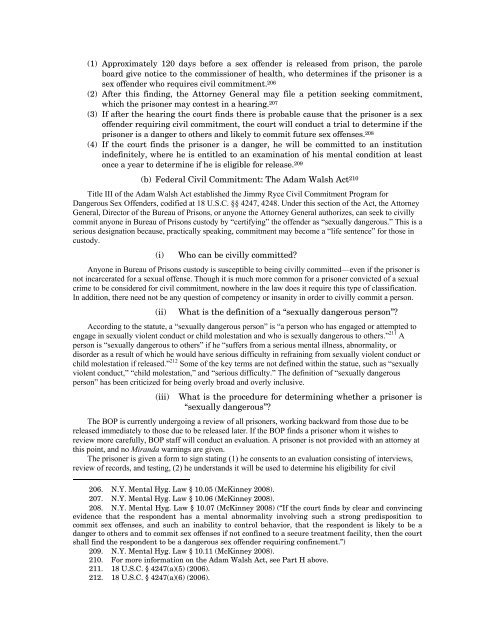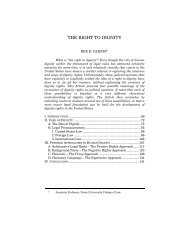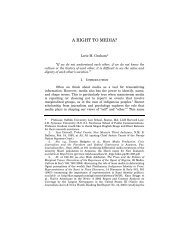Special considerations for sex offenders - Columbia Law School
Special considerations for sex offenders - Columbia Law School
Special considerations for sex offenders - Columbia Law School
Create successful ePaper yourself
Turn your PDF publications into a flip-book with our unique Google optimized e-Paper software.
(1) Approximately 120 days be<strong>for</strong>e a <strong>sex</strong> offender is released from prison, the paroleboard give notice to the commissioner of health, who determines if the prisoner is a<strong>sex</strong> offender who requires civil commitment. 206(2) After this finding, the Attorney General may file a petition seeking commitment,which the prisoner may contest in a hearing. 207(3) If after the hearing the court finds there is probable cause that the prisoner is a <strong>sex</strong>offender requiring civil commitment, the court will conduct a trial to determine if theprisoner is a danger to others and likely to commit future <strong>sex</strong> offenses. 208(4) If the court finds the prisoner is a danger, he will be committed to an institutionindefinitely, where he is entitled to an examination of his mental condition at leastonce a year to determine if he is eligible <strong>for</strong> release. 209(b) Federal Civil Commitment: The Adam Walsh Act 210Title III of the Adam Walsh Act established the Jimmy Ryce Civil Commitment Program <strong>for</strong>Dangerous Sex Offenders, codified at 18 U.S.C. §§ 4247, 4248. Under this section of the Act, the AttorneyGeneral, Director of the Bureau of Prisons, or anyone the Attorney General authorizes, can seek to civillycommit anyone in Bureau of Prisons custody by “certifying” the offender as “<strong>sex</strong>ually dangerous.” This is aserious designation because, practically speaking, commitment may become a “life sentence” <strong>for</strong> those incustody.(i)Who can be civilly committed?Anyone in Bureau of Prisons custody is susceptible to being civilly committed—even if the prisoner isnot incarcerated <strong>for</strong> a <strong>sex</strong>ual offense. Though it is much more common <strong>for</strong> a prisoner convicted of a <strong>sex</strong>ualcrime to be considered <strong>for</strong> civil commitment, nowhere in the law does it require this type of classification.In addition, there need not be any question of competency or insanity in order to civilly commit a person.(ii)What is the definition of a “<strong>sex</strong>ually dangerous person”?According to the statute, a “<strong>sex</strong>ually dangerous person” is “a person who has engaged or attempted toengage in <strong>sex</strong>ually violent conduct or child molestation and who is <strong>sex</strong>ually dangerous to others.” 211 Aperson is “<strong>sex</strong>ually dangerous to others” if he “suffers from a serious mental illness, abnormality, ordisorder as a result of which he would have serious difficulty in refraining from <strong>sex</strong>ually violent conduct orchild molestation if released.” 212 Some of the key terms are not defined within the statue, such as “<strong>sex</strong>uallyviolent conduct,” “child molestation,” and “serious difficulty.” The definition of “<strong>sex</strong>ually dangerousperson” has been criticized <strong>for</strong> being overly broad and overly inclusive.(iii) What is the procedure <strong>for</strong> determining whether a prisoner is“<strong>sex</strong>ually dangerous”?The BOP is currently undergoing a review of all prisoners, working backward from those due to bereleased immediately to those due to be released later. If the BOP finds a prisoner whom it wishes toreview more carefully, BOP staff will conduct an evaluation. A prisoner is not provided with an attorney atthis point, and no Miranda warnings are given.The prisoner is given a <strong>for</strong>m to sign stating (1) he consents to an evaluation consisting of interviews,review of records, and testing, (2) he understands it will be used to determine his eligibility <strong>for</strong> civil206. N.Y. Mental Hyg. <strong>Law</strong> § 10.05 (McKinney 2008).207. N.Y. Mental Hyg. <strong>Law</strong> § 10.06 (McKinney 2008).208. N.Y. Mental Hyg. <strong>Law</strong> § 10.07 (McKinney 2008) (“If the court finds by clear and convincingevidence that the respondent has a mental abnormality involving such a strong predisposition tocommit <strong>sex</strong> offenses, and such an inability to control behavior, that the respondent is likely to be adanger to others and to commit <strong>sex</strong> offenses if not confined to a secure treatment facility, then the courtshall find the respondent to be a dangerous <strong>sex</strong> offender requiring confinement.”)209. N.Y. Mental Hyg. <strong>Law</strong> § 10.11 (McKinney 2008).210. For more in<strong>for</strong>mation on the Adam Walsh Act, see Part H above.211. 18 U.S.C. § 4247(a)(5) (2006).212. 18 U.S.C. § 4247(a)(6) (2006).















